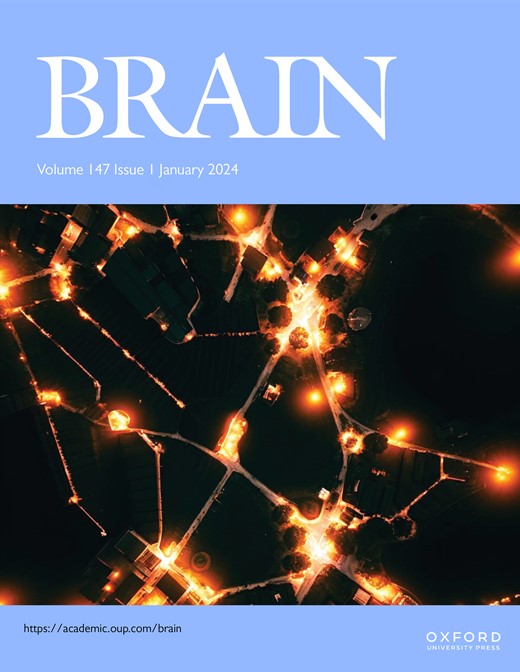STT3A和ALG5在老年猕猴海马糖代谢中的代偿作用。
IF 11.7
1区 医学
Q1 CLINICAL NEUROLOGY
引用次数: 0
摘要
海马体(HC)是记忆和认知的中心枢纽,尽管普遍存在脑葡萄糖代谢低下,但在衰老过程中仍表现出独特的代谢弹性。在这里,我们报告了老年人和猕猴自相矛盾地表现出升高的HC葡萄糖摄取(18F-FDG PET SUVR),同时增强了与感觉-运动和边缘网络的连通性——图理论代谢网络分析揭示了一种适应性重新连接。综合多组学分析发现,STT3A(寡糖基转移酶)和ALG5(多羟基磷酸β-葡萄糖基转移酶)是年龄相关HC适应的关键调节因子,它们在老年猕猴海马中的上调驱动n-糖基化依赖性代谢重编程。在机制上,老年大鼠STT3A/ALG5沉默降低了胰岛素受体/AKT1/AS160磷酸化,损害了GLUT4膜运输,同时增强了GLUT3糖基化和神经元葡萄糖摄取。这种双重调节保留了突触完整性和空间记忆检索,尽管海马FDG代谢减少。行为学分析进一步证明STT3A敲低通过glut3介导的代谢再平衡诱导运动协调改善。我们的研究结果表明,STT3A-ALG5是一个糖基化检查点,通过GLUT4-to-GLUT3底物转换维持HC能量稳态,将18F-FDG PET定位为监测HC衰老的动态生物标志物,并将这些糖基转移酶定位为对抗认知能力下降的治疗靶点。本文章由计算机程序翻译,如有差异,请以英文原文为准。
Compensatory roles of STT3A and ALG5 in glucose metabolism of aged macaque hippocampus.
The hippocampus (HC), a central hub for memory and cognition, exhibits unique metabolic resilience during aging despite widespread brain glucose hypometabolism. Here, we report that aged humans and macaques paradoxically display elevated HC glucose uptake (18F-FDG PET SUVR) alongside strengthened connectivity to sensory-motor and limbic networks-an adaptive rewiring revealed by graph-theoretical metabolic network analysis. Integrated multi-omics profiling identified STT3A (oligosaccharyltransferase) and ALG5 (dolichyl-phosphate β-glucosyltransferase) as key regulators of age-related HC adaptation, with their upregulation in aged macaque hippocampi driving N-glycosylation-dependent metabolic reprogramming. Mechanistically, STT3A/ALG5 silencing in aged rats reduced insulin receptor/AKT1/AS160 phosphorylation, impairing GLUT4 membrane trafficking, while enhancing GLUT3 glycosylation and neuronal glucose uptake. This dual regulation preserved synaptic integrity and spatial memory retrieval despite reduced hippocampal FDG metabolism. Behavioral assays further demonstrated STT3A knockdown-induced motor coordination improvements through GLUT3-mediated metabolic rebalancing. Our findings establish STT3A-ALG5 as a glycosylation checkpoint that sustains HC energy homeostasis via GLUT4-to-GLUT3 substrate switching, positioning 18F-FDG PET as a dynamic biomarker for monitoring HC aging and these glycosyltransferases as therapeutic targets against cognitive decline.
求助全文
通过发布文献求助,成功后即可免费获取论文全文。
去求助
来源期刊

Brain
医学-临床神经学
CiteScore
20.30
自引率
4.10%
发文量
458
审稿时长
3-6 weeks
期刊介绍:
Brain, a journal focused on clinical neurology and translational neuroscience, has been publishing landmark papers since 1878. The journal aims to expand its scope by including studies that shed light on disease mechanisms and conducting innovative clinical trials for brain disorders. With a wide range of topics covered, the Editorial Board represents the international readership and diverse coverage of the journal. Accepted articles are promptly posted online, typically within a few weeks of acceptance. As of 2022, Brain holds an impressive impact factor of 14.5, according to the Journal Citation Reports.
 求助内容:
求助内容: 应助结果提醒方式:
应助结果提醒方式:


